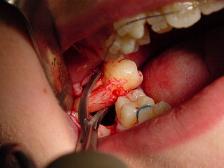
A dental extraction is the surgical removal of a tooth from the mouth. Simple extractions may be done by a dentist, and are performed on teeth that are visible in the mouth, under local anaesthetic. Typically the dentist grasps the tooth with forceps, rocking it back and forth until it is loosened from the alveolar bone. Sometimes a luxator, an instrument which fits between the tooth and gum, is used to help loosten the tooth. Surgical extractions are performed by an oral surgeon and involve the removal of teeth that cannot be easily accessed, either because it has broken under the gum line or because it has not come in yet. In a surgical extraction the surgeon makes an incision in the gum to reach the tooth and may also require the removal of overlying bone tissue. After the tooth is removed, a clot will usually form in the socket. Occasionally this clot can become disloged, resulting in a condition called dry socket. This will lengthen the healing process and cause additional pain and discomfort.
A tooth may be removed for a variety of reasons. It may be badly damaged or decayed, could be impacted, could be causing overcrowding or preventing a tooth from erupting.
Historically, dental extractions have been used to treat a variety of illnesses. Before the discovery of antibiotics chronic tooth infections were often linked to a variety of health problems, and therefore removal of a diseased tooth was a common treatment for various medical conditions. Instruments used for dental extractions date back several centuries. In the 14th century, Guy de Chauliac invented the dental pelican (resembling a pelican's beak) which was used through the late 18th century. The pelican was replaced by the dental key which, in turn, was replaced by modern forceps in the 20th century. Potzomchick 16:09, 25 August 2005 (UTC)